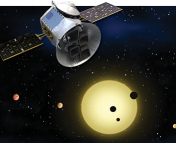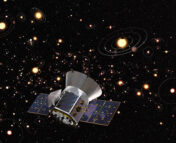Title: The TESS-Keck Survey. VIII. Confirmation of a Transiting Giant Planet on an Eccentric 261 day Orbit with the Automated Planet Finder Telescope
Authors: Paul A. Dalba, Stephen R. Kane, Diana Dragomir, and 72 additional authors
First Author’s Institution: Department of Astronomy and Astrophysics, University of California, Santa Cruz, CA 95064, USA and Department of Earth and Planetary Sciences, University of California Riverside, 900 University Ave, Riverside, CA 92521, USA
Status: Published in The Astronomical Journal [open access]
Slow Going
Few objects in this universe are more peaceful than giant, far-out, slow moving planets. Serenely cruising along on their wide orbits while their gorgeous clouds slowly churn, they aren’t as flashy as their close-in, Hot Jupiter cousins who whip around their host star getting blasted with intense radiation all the way. They mostly do their own thing, usually don’t get puffed-up and certainly don’t disintegrate. Good vibes all around.
Their tranquility isn’t just admirable, it’s also scientifically interesting. Some models predict that a few of these gentle giants will undergo a change of heart, and someday will migrate closer to the action and eventually become Hot Jupiters themselves. Verifying this origin story will require more data on these potential progenitors though, so astronomers have a strong incentive to investigate these slow riders.
Unfortunately, the same slow pace and wide separations which make these planets so chill also makes them very, very hard to find. The further away a planet is from its star, the less likely that its orbit just happens to line up correctly for us on Earth to observe a transit, and on top of that, the longer it takes for the planet to make a full lap around its star, the more patient we have to be to measure either a transit or its radial velocity signature. Consequently, these huge but relaxed planets on orbits longer than 200 days are rare in our catalogs, and it’s a big deal whenever astronomers find a new one.
Today’s authors did just that! In early 2022, they formally introduced the world to TOI-2180 b, a behemoth of a planet which transits its host star at a snail’s pace. As exciting as the scientific result is though, the degree of collaboration which enabled it elevates this story from that of an isolated study to a compelling illustration of the process of scientific discovery.
Telescopes and more telescopes
The story begins in May of 2020, when citizen scientists spotted an absurdly long ~24 hour long transit in data collected by the TESS mission (telescope count: 1). Assuming the planet was on a circular orbit, the time the planet took to cross in front of its host star initially suggested that it was cruising along on a >500 day orbit. This was exciting but problematic, since TESS has a short attention span and likes to move quickly around the sky without lingering long enough to catch such long period planets. So, it was time to bring in backup, and the team immediately started monitoring TOI-2180 at the Lick observatory (telescope count: 2), hoping to catch signs of a planet tugging on its star and periodically changing its radial velocity (RV).
They didn’t stop there! A few months later, they commandeered the Gemini North telescope to check for any coincidentally nearby stellar companions which could have contaminated the signal (telescope count: 3). Soon, more earthly events started shaping these celestial pursuits: wildfires broke out in California and forced Lick to temporarily abandon its campaign, but the team picked up the ball with the Keck telescopes in Hawaii and kept the RV data flowing (telescope count: 4). Over time, using the RV data the team refined their initial guess about the planet’s period: now it looked like the planet was slightly eccentric and would take more like 270 days to complete a lap, shorter than the original 500.

And here is where the human coordination got really intense. At this point, the team knew the planet was going to make a rare appearance and transit again sometime around the end of August, 2020. Crucially though, they didn’t know exactly when, and the best they could do was bound the time to within about 10 days. That’s too long for one major telescope to stare at one star; plus, with a 24 hour transit, no one spot on earth would be able to record the whole thing (the whole “daylight” part of the day is a downer for ground-based exoplanet science). The only way to catch this transit would be to assemble a team which somehow spanned the globe and could watch for long enough to cover the entire window of possibilities.
Undaunted by the logistics of such an operation, that’s just what these authors did. From 14 different sites, they took over 20,000 images looking for the transit with 15 telescopes. That brings our score to 19 telescopes involved in the discovery of this planet. 19!
Despite all this effort, no one managed to catch the transit during that window. But! Null results are still useful results, and by confidently knowing when the transit didn’t happen, they could better constrain when it could have happened.
.

Overall, it was a bittersweet attempt: inspiring in its global reach and definitely scientifically valuable, but lacking that final “got’em!” moment of a successful recovery.
Epilogue
Although that’s where these authors left it in January, since then the story has reached a more satisfying conclusion. TESS took us full circle and observed TOI-2180 again in early 2022, and it managed what the ground-based collaboration struggled to do: it recorded and precisely timed the entire 24 hour transit. And wouldn’t you know it, the period fell exactly where the authors predicted based via their ground work!

With two well-measured transits, we now have a solid understanding of the planet’s orbit and can predict when it will pop up again. Thanks to this massive collaboration between professional astronomers, citizen scientists, and dozens of observing facilities around the world, we know a little bit more about our galactic backyard, and can look forward to years of future studies of this chill, distant world.
Astrobite edited by Konstantin Gerbig
Featured image credit: NASA/JPL-Caltech/R. Hurt




